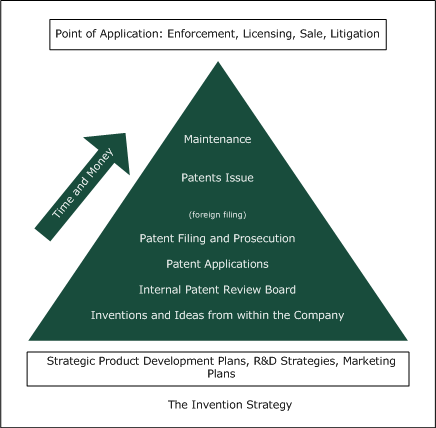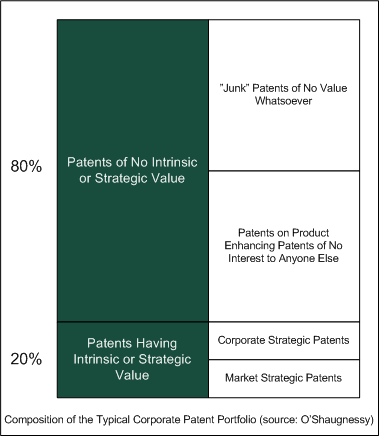|
|
The Invention Strategy
and why it fails
The
patent process at most companies is comfortingly familar. Engineers,
scientists, and product development experts in one part of the company
come up with ideas and submit them to a patent review board. The
patent review board selects which ideas will be forwarded to the
legal department for patenting. It is an organic process, driven
from the bottom up and generally unadulterated by strategic concepts.
Experience
shows that patent review boards, made up of technical experts, technical
managers, and product managers invariably measure the value of any
inventions based on its benefits to product commercialization and/or
technical merits. The typical selection process is dominated by the
view that the value of a patent lies in the value of the invention
to the company’s own product development and marketing plans. The
result of this is that the strategy for inventions - the R&D
strategy - becomes the strategy for patents.
The Invention Strategy
is a strategy for inventions: what is needed is a strategy for patents.

A Strategy for
Patents
It
is obvious that the business
value of any patent portfolio depends
on what patents are actually in the portfolio. Ideally, a company's
patent portfolio should be a well-focused reflection of the strategic
business goals of the company. In
reality, however, when the patent portfolios of many large companies
are studied, the reflection is an altogether different one. In
study after study, there is a remarkable similarity in the make-up
of most patent portfolios. The fact of the matter is that many
patent portfolios are filled with obsolete or "junk" patents
- or patents on productivity-enhancing technologies that
have little value outside of the specific circumstances of the
company.

For
all too many organizations, patenting is a horribly expensive
and indefensibly inefficient activity. Patent
engineering is aimed at improving efficiencies, lowering costs,
and focusing effort on patents of intrinsic or strategic value.
* O'Shaughnessy,
James P. "Strategy for the Times: Intellectual Property Can
Drive Corporate Profitability" from the book "Technology
Licensing" edited by Parr, Russell and Sullivan, Patrick,
John Wiley & Sons, 1996, p. 147-150
|

|
|
|
"80%
of the patents in most portfolios lack the ability to alter
either the calculus or dynamics of the marketplace" [...]
and "cover technology that has little if any intrinsic
value."*
O'Shaughnessy,
James P. "Strategy for the Times: Intellectual Property
Can Drive Corporate Profitability" |
|
| " 'Good
companies use only 20 percent of their patents,' said Sam Khoury,
the president of Inavisis International, a consulting firm
that appraises patents, trademarks and related corporate assets.
'Badly run companies use only 10 percent.' "
Patent
Donations are Novel Corporate Gift, The New York Times,
November 17, 2002 |
|







